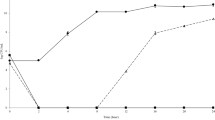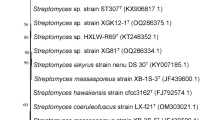Abstract
Previous studies demonstrated that ursolic acid (UA) present in apple pomace displays antimicrobial activity against some microorganisms, but the underlying mechanisms associated with this activity remain unexplored. Furthermore, there are no reports on the effect of UA on carbapenem-resistant Klebsiella pneumoniae (CRKP). This study examined the antimicrobial activity and mode of action of UA against CRKP was examined. Minimum inhibitory concentration (MIC) of UA against CRKP was determined by the agar dilution method. Variations in the intracellular pH (pHin), ATP concentration, and cell membrane potential were measured to assess the influence of UA on the cell membrane. Our results show that UA was effective against CRKP at an MIC of 0.8 mg ml−1. UA disrupted the cell membrane integrity of CRKP, exhibited strong inhibitory effects against biofilm formation and biofilm-related gene expression, and inactivated CRKP cells encased in biofilms. Thus, UA shows promise for use in combination with other antibiotics to treat multidrug resistant K. pneumoniae infections.
This is a preview of subscription content, access via your institution
Access options
Subscribe to this journal
Receive 12 print issues and online access
$259.00 per year
only $21.58 per issue
Buy this article
- Purchase on Springer Link
- Instant access to full article PDF
Prices may be subject to local taxes which are calculated during checkout







Similar content being viewed by others
References
Ghafur A, Shankar C, GnanaSoundari P, Venkatesan M, Mani D, Thirunarayanan MA, et al. Detection of chromosomal and plasmid-mediated mechanisms of colistin resistance in Escherichia coli and Klebsiella pneumoniae from Indian food samples. J Glob Antimicrob Resist. 2019;16:48–52.
Navon-Venezia S, Kondratyeva K, Carattoli A. Klebsiella pneumoniae: a major worldwide source and shuttle for antibiotic resistance. Fems Microbiol Rev. 2017;41:252–75.
Ni WT, Li GB, Zhao J, Cui JC, Wang R, Gao ZC, et al. In vitro activity of minocycline combined with aminoglycosides against Klebsiella pneumoniae carbapenemase-producing K-pneumoniae. J Antibiot. 2018;71:506–13.
Martin RM, Bachman MA. Colonization, infection, and the accessory genome of Klebsiella pneumoniae. Front Cell Infect Microbiol. 2018;8:4.
Papayannopoulos V. Neutrophils facing biofilms: the battle of the barriers. Cell Host Microbe. 2019;25:477–9.
Banerjee J, Singh R, Vijayaraghavan R, et al. Bioactives from fruit processing wastes: green approaches to valuable chemicals. Food Chem. 2016;225:10–22.
Xiong X, Yu IKM, Tsang DCW, Bolan NS, Sik Ok Y, Igalavithana AD, et al. Value-added chemicals from food supply chain wastes: State-of-the-art review and future prospects. Chem Eng J. 2019;375. https://doi.org/10.1016/j.cej.2019.121983.
Padam BS, Tin HS, Chye FY, Abdullah MI. Banana by-products: an under-utilized renewable food biomass with great potential. J Food Sci Technol. 2014;51:3527–45.
Duan NB, Bai Y, Sun HH, Wang N, Ma YM, Li MJ, et al. Genome re-sequencing reveals the history of apple and supports a two-stage model for fruit enlargement. Nat Commun. 2017;8. https://doi.org/10.1038/s41467-017-00336-7.
Vendruscolo F, Albuquerque PM, Streit F, Esposito E, Ninow JL. Apple pomace: a versatile substrate for biotechnological applications. Crit Rev Biotechnol. 2008;28:1–12.
Cargnin ST, Gnoatto SB. Ursolic acid from apple pomace and traditional plants: a valuable triterpenoid with functional properties. Food Chem. 2017;220:477–89.
Jin H, Pi J, Yang F, Wu C, Cheng X, Bai H, et al. Ursolic acid-loaded chitosan nanoparticles induce potent anti-angiogenesis in tumor. Appl Microbiol Biotechnol. 2016;100:6643–52.
Do Nascimento PGG, Lemos TLG, Bizerra AMC, Arriaga AMC, Ferreira DA, Santiago GMP, et al. Antibacterial and antioxidant activities of ursolic acid and derivatives. Molecules. 2014;19:1317–27.
Srisrattakarn A, Lulitanond A, Wilailuckana C, Charoensri N, Wonglakorn L, Saenjamla P. Rapid and simple identification of carbapenemase genes, blaNDM, blaOXA-48, blaVIM, blaIMP-14 and blaKPC groups, in gram-negative bacilli by in-house loop-mediated isothermal amplification with hydroxynaphthol blue dye. World J Micro Biot. 2017;33:130.
European Committee for Antimicrobial Susceptibility Testing of the European Society of Clinical M, Infectious D. EUCAST Definitive Document E.DEF 3.1, June 2000: determination of minimum inhibitory concentrations (MICs) of antibacterial agents by agar dilution. Clin Microbiol Infect. 2000;6:509–15.
Bharitkar YP, Bathini S, Ojha D, Ghosh S, Mukherjee H, Kuotsu K, et al. Antibacterial and antiviral evaluation of sulfonoquinovosyl diacylglyceride: a glycolipid isolated from Azadirachta indica leaves. Lett Appl Microbiol. 2014;58:184–9.
Shi C, Song K, Zhang X, Sun Y, Sui Y, Chen Y, et al. Antimicrobial activity and possible mechanism of action of citral against Cronobacter sakazakii. PLoS ONE. 2016;11:e0159006.
Huang E, Yousef AE. The lipopeptide antibiotic paenibacterin binds to the bacterial outer membrane and exerts bactericidal activity through cytoplasmic membrane damage. J Appl Environ Microbiol. 2014;80:2700–4.
Sanchez E, Garcia S, Heredia N. Extracts of edible and medicinal plants damage membranes of Vibrio cholerae. Appl Environ Microbiol. 2010;76:6888–94.
Casini B, Baggiani A, Totaro M, Mansi A, Costa AL, Aquino F, et al. Detection of viable but non-culturable legionella in hospital water network following monochloramine disinfection. J Hosp Infect. 2018;98:46–52.
Shi C, Sun Y, Zheng Z, Zhang X, Song K, Jia Z, et al. Antimicrobial activity of syringic acid against Cronobacter sakazakii and its effect on cell membrane. Food Chem. 2016;197:100–6.
Zhao Y, Chen M, Zhao Z, Yu S. The antibiotic activity and mechanisms of sugarcane (Saccharum officinarum L.) bagasse extract against food-borne pathogens. Food Chem. 2015;185:112–8.
Yue J, Yang H, Liu S, Song F, Guo J, Huang C. Influence of naringenin on the biofilm formation of Streptococcus mutans. J Dent. 2018;76:24–31.
Xu Y, Shi C, Wu Q, Zheng Z, Liu P, Li G, et al. Antimicrobial activity of punicalagin against Staphylococcus aureus and its effect on biofilm formation. Foodborne Pathog Dis. 2017;14:282–7.
Garcia-Heredia A, Garcia S, Merino-Mascorro JA, Feng P, Heredia N. Natural plant products inhibits growth and alters the swarming motility, biofilm formation, and expression of virulence genes in enteroaggregative and enterohemorrhagic Escherichia coli. Food Microbiol. 2016;59:124–32.
Liu F, Du LH, Zhao T, Zhao P, Doyle MP. Effects of phenyllactic acid as sanitizing agent for inactivation of Listeria monocytogenes biofilms. Food Control. 2017;78:72–8.
Neuner EA, Yeh JY, Hall GS, Sekeres J, Endimiani A, Bonomo RA, et al. Treatment and outcomes in carbapenem-resistant Klebsiella pneumoniae bloodstream infections. Diagn Microbiol Infect Dis. 2011;69:357–62.
Zhang RS, Qin XF, Kong FD, Chen PW, Pan GJ. Improving cellular uptake of therapeutic entities through interaction with components of cell membrane. Drug Deliv. 2019;26:328–42.
Johnston MD, Hanlon GW, Denyer SP, Lambert RJ. Membrane damage to bacteria caused by single and combined biocides. J Appl Microbiol. 2003;94:1015–23.
Wu Y, Bai J, Zhong K, Huang Y, Qi H, Jiang Y, et al. Antibacterial activity and membrane-disruptive mechanism of 3-p-trans-Coumaroyl-2-hydroxyquinic acid, a Novel phenolic compound from pine needles of Cedrus deodara, against Staphylococcus aureus. Molecules. 2016;21. https://doi.org/10.3390/molecules21081084.
Zore GB, Thakre AD, Jadhav S, Karuppayil SM. Terpenoids inhibit Candida albicans growth by affecting membrane integrity and arrest of cell cycle. Phytomedicine. 2011;18:1181–90.
Jamal M, Ahmad W, Andleeb S, Jalil F, Imran M, Nawaz MA, et al. Bacterial biofilm and associated infections. J Chin Med Assoc. 2018;81:7–11.
Qian W, Zhang J, Wang W, et al. Antimicrobial and antibiofilm activities of paeoniflorin against carbapenem-resistant Klebsiella pneumoniae. J Appl Microbiol. 2019. https://doi.org/10.1111/jam.14480.
Mohamed SH, Mohamed MSM, Khalil MS, Azmy M, Mabrouk MI. Combination of essential oil and ciprofloxacin to inhibit/eradicate biofilms in multidrug-resistant Klebsiella pneumoniae. J Appl Microbiol. 2018;125:84–95.
Chung PY, Khanum R. Antimicrobial peptides as potential anti-biofilm agents against multidrug-resistant bacteria. J Microbiol Immunol Infect. 2017;50:405–10.
Liu F, Wang FT, Du LH, Zhao T, Doyle MP, Wang DY, et al. Antibacterial and antibiofilm activity of phenyllactic acid against Enterobacter cloacae. Food Control. 2018;84:442–8.
Acknowledgements
This study was funded by the National Natural Science Foundation of China (11975177, 11575149), the Key Research and Development Project of Shaanxi Province (2019XY-03, 2019NY-004, 2019JM-184), and the Industry Cultivation Project of Education Department of Shaanxi Provincial Government (18JC006, 18JC007).
Author information
Authors and Affiliations
Corresponding authors
Ethics declarations
Conflict of interest
The authors declare that they have no conflict of interest.
Ethical approval
This article does not contain any studies with human participants or animal performed by any of the authors.
Additional information
Publisher’s note Springer Nature remains neutral with regard to jurisdictional claims in published maps and institutional affiliations.
Supplementary information
Rights and permissions
About this article
Cite this article
Qian, W., Wang, W., Zhang, J. et al. Antimicrobial and antibiofilm activities of ursolic acid against carbapenem-resistant Klebsiella pneumoniae. J Antibiot 73, 382–391 (2020). https://doi.org/10.1038/s41429-020-0285-6
Received:
Revised:
Accepted:
Published:
Issue Date:
DOI: https://doi.org/10.1038/s41429-020-0285-6
This article is cited by
-
In-vitro antibacterial activity and mechanism of Monarda didyma essential oils against Carbapenem-resistant Klebsiella pneumoniae
BMC Microbiology (2023)
-
Antibacterial, anti-efflux, anti-biofilm, anti-slime (exopolysaccharide) production and urease inhibitory efficacies of novel synthesized gold nanoparticles coated Anthemis atropatana extract against multidrug- resistant Klebsiella pneumoniae strains
Archives of Microbiology (2020)



